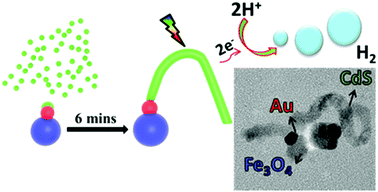Synthesis of magnetically separable Fe3O4–Au–CdS kinked heterotrimers incorporating plasmonic and semiconducting functionalities†
Abstract
Dimension, composition and configuration are the primary aspects of semiconductor based hybrid heterostructures that govern their properties. To achieve desired functionalities within a single nanoparticle system, numerous synthetic approaches are available which may be suitable for achieving the target combination but these can be complex and tedious. In this work, a simple seeded-growth approach was employed to obtain an iron oxide–gold–cadmium sulfide (Fe3O4–Au–CdS) heterotrimer with a unique morphology manifesting magnetic, plasmonic and semiconducting properties. In a straightforward two-step synthesis process, Au–Fe3O4 dimer was injected as a seed into the Cd precursor solution for the growth of one-dimensional (1D) kinked CdS-5 nanorods on it. The synthesized Fe3O4–Au–CdS heterotrimer was tested in photocatalytic water-reduction reaction, revealing its potential as a photocatalyst for the hydrogen evolution reaction (HER), where each domain within the heterotrimer played a distinct role including light absorption, charge separation and magnetic separation. A post-synthetic modification on the semiconductor part was also performed where kinked CdS nanorod was cation exchanged with Ag2S leading to the formation of another heterotrimer of Fe3O4–Au–Ag2S while retaining the same morphology and expanding the palette of heterotrimers.



 Please wait while we load your content...
Please wait while we load your content...